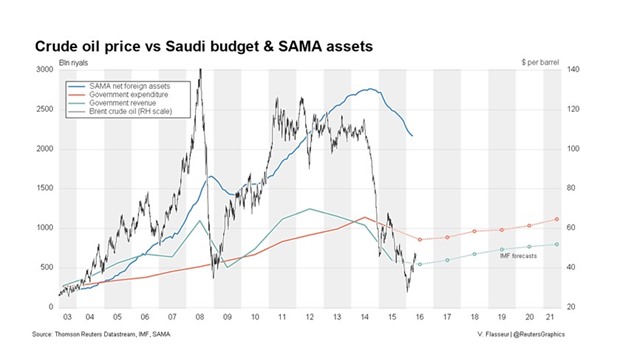For anyone betting Saudi Arabia’s banks are entering a resurgent phase after their earnings crushed analyst estimates in the first quarter, here’s a reality check.
Borrowing costs in the kingdom have risen to the highest in seven years, bad loans are forecast to jump after an increase in lending to companies hurt by payment delays, and economic growth is poised to slow by more than half this year. Little wonder, then, that analysts have turned the most sceptical since April 2015 on the outlook for Saudi banks, cutting their earnings projections for four successive months.
The business environment “will get difficult from here,” said Murad Ansari, a Riyadh-based analyst at EFG-Hermes Holding, the largest listed Arab investment bank. Ansari downgraded two Saudi lenders to neutral last month and one to sell. “The big issues over the next few quarters will be the rise in provisions for bad loans and a jump in the cost of funding. Provisioning was fairly benign in the first quarter and should rise steadily from the second half.”
The deteriorating outlook for Saudi Arabia’s almost $600bn banking industry is a sign of the stresses hobbling the country at a time when the government is seeking to usher in economic changes designed to cut dependence on oil revenue. The more than 50% slump in crude prices in the past two years has left the world’s biggest oil exporter grappling with a budget deficit near the widest in more than two decades, and government borrowing may top 120bn riyals ($32bn) in 2016.
Analysts polled by Bloomberg have reduced profit estimates for Saudi banks by 10% since September to 1,503 riyals per share. In contrast, they turned bullish on emerging-market peers this year, raising projections by 4.2% since a low in January.
S&P Global Ratings increased its risk rating on Saudi Arabia’s banking industry by one level last Monday, citing the likely increase in banks’ non-performing loans and credit losses amid slower economic growth sparked by oil’s drop.
Still, the banking system comprises a small number of domestic players benefiting from well-protected franchises with high barriers to entry, it said. National Commercial Bank and Al Rajhi Bank, the kingdom’s two biggest lenders, account for 35% of the industry’s total assets.
Nine of 12 publicly traded banks in the kingdom beat profit expectations in the first quarter, as lending grew 3.4%, accelerating from a 2.4% increase in the previous quarter, according to central bank data.
The jump was partly driven by additional lending to contractors as the government delayed payments, according to Olivier Panis, a Dubai-based vice-president at Moody’s Investors Service.
Moody’s in March cut its outlook on Saudi banks to negative, citing the collapse in oil prices and falling government spending. The rating company forecast non-performing loans will rise to about 2.5% of total loans over the next 12 to 18 months, from a “very low average” of 1.4% in September.
“Usually, non-performing loans pick up six months after economic growth slows so there is still more pain to come,” said Jaap Meijer, a Dubai-based managing director for research at Arqaam Capital Ltd. “We will start to see the economy slow only now and so the real test will be six months hence at around the fourth quarter.”
Meijer expects Saudi banks’ profit to climb by about 6% in 2016, before falling by 3% next year. Provisions will grow this year, he said.
Economic growth will slow by more than half in 2016 to 1.5%, according to the median estimate of 13 analysts compiled by Bloomberg. The kingdom is cutting spending by 14% this year and has reduced subsidies on fuel, electricity and water.
Borrowing costs among lenders are at the highest since January 2009. The three-month Saudi Interbank Offered Rate, a benchmark used to price loans, rose 1 basis point to 2.07% on Tuesday. It climbed above 2% last month even as data showed liquidity in the banking system improved in March. An increase in deposits helped Saudi banks’ loans-to- deposit ratio drop to 87.5% from 88.1% a month earlier.
“Banks’ funding costs will go up immediately over the next two quarters considering there is a liquidity squeeze and the interbank rates have gone up,” said Chiradeep Ghosh, a Bahrain- based analyst at Securities & Investment Co. Bad loan provisions will “definitely increase from the second or the third quarter,” he said.
Ansari at EFG-Hermes forecast earnings at Saudi banks will decline 7% this year from 2015. Their non-performing loans ratio may climb to 1.5% from 1.1% in 2015 and to 2.3% next year, he said. Ghosh at SICO Bahrain said he expects Saudi banks’ profit to be about flat compared to last year.

PROFIT
